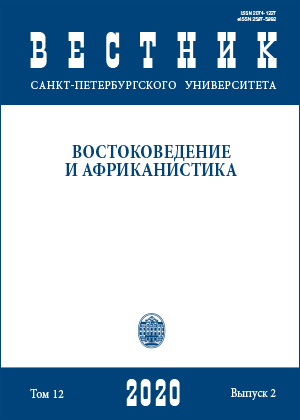Main Trends of the Eurasian Concepts in Japan at the turn of the 21st Century: Approaches within Academic and Political Discourses
DOI:
https://doi.org/10.21638/spbu13.2020.208Abstract
The paper deals with the formation of ‘Eurasian concepts’ in Japan (called here ‘Eurasianism’) among academicians at the turn of the 20th — 21st centuries, including the considered by us definition of the ‘Eurasianism’, the explanation of the rise of a new Eurasian academic school in the Post-Cold-War decades and the dissemination of common concepts of Eurasia, spread in texts and utterances by academicians and politicians. In the paper it is aimed to present the most pervasive terms of Eurasian concepts in Japan in its political, cultural, economic dimensions, such as ‘Political Eurasian concept’ and three approaches within ‘Academic Eurasian concept’ (Great Eurasian Powers, Eurasian boarder studies, Central Eurasia cultural studies). The focus of our analysis is ideas provided by contemporary Japanese researchers in the field of politics, economics and area studies. The beginning of the rise of these ideas dates back to the 1990s when the new Eurasian region appeared on the political map of the world with the core of Central Asian nations, the Caucasian states and Russian Federation. The reshaping of huge Eurasian space influenced by China and Russia made a challenge to the Japanese politics and academia at the same time, then by the end of 1990s scholars in Japan drew up their vision toward political structures, boarders, economic features in Eurasia. In 2000s — 2010s approaches of this kind had become common in the Japanese political science and economics. We are mostly drawing attention to the texts and concepts by members of the Slavic-Eurasian Center of Hokkaido University as a leading thinking tank in the area of Eurasian studies in Japan.
Keywords:
Eurasian studies, Great Silk Road, Great Powers, boarder studies, Iwashita Akihiro, Inoue Yasushi.
Downloads
References
Downloads
Published
How to Cite
Issue
Section
License
Articles of "Vestnik of Saint Petersburg University. Asian and African Studies" are open access distributed under the terms of the License Agreement with Saint Petersburg State University, which permits to the authors unrestricted distribution and self-archiving free of charge.





